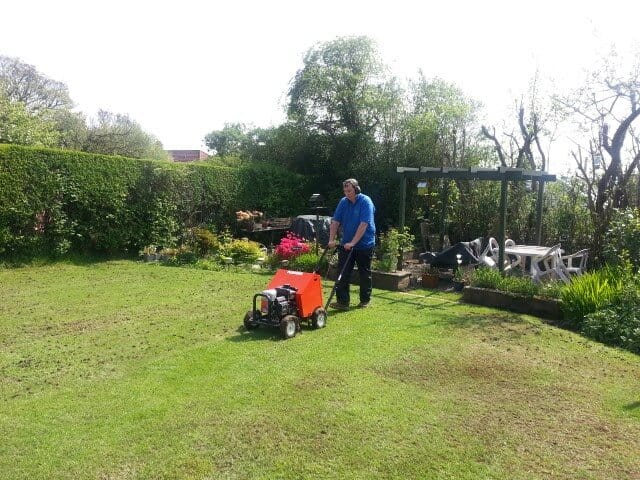Aeration – Why do it?
In order to achieve and maintain a premier lawn, it is important not only to mow the lawn, it is important to remember what goes on beneath the soil.
Aeration is the making of holes in the lawns surface.
The action of aerating will let the stale carbon dioxide air out of the soil and the fresh oxygen rich air into

the soil. Aeration is the process of relieving compaction and increasing air space to help promote healthy growing conditions for grass.
All soil types are vulnerable to compaction, although heavy clay soils are more prone to this than light sandy soils due to the small soil particles of clay.
Compaction is basically a result of compression placed on the soil particles, which causes a breakdown in soil structure resulting in lack of air.
Compaction causes the pore spaces in the soil to become small, thus reducing the amount of air held in the root zone. This inhibits drainage, has a negative effect on rooting, encourages shallow rooted grasses which in turn will reduce drought resistance.
Lack of air also has a negative effect on micro organisms in the soil, which need air to survive. Micro organisms are required to break down the thatch layer and return nutrients to the plant.
 How Often Should You Aerate a Lawn?
How Often Should You Aerate a Lawn?
Most lawns benefit from annual aeration. Heavily used lawns, or those growing on heavy clay or subsoil’s may need more than one aeration each year.
When to aerate your lawn
Aeration can be carried out at any time during the year subject to ground and soil conditions. Ideally the soil needs to be slightly moist to get the full benefit from aeration. Avoid aerating during frosty conditions, the obvious reason it that you will damage the grass.
How and when to aerate
There is any number of different ways to aerate turf, the old fashion method being a garden fork, however it’s not recommended for anything much bigger than a couple of square metres. Typically a mechanical aerator will be required and they come in all shapes and sizes.
If asked, I would always recommend it is not so important as to how you aerate the lawn, more that it is carried out.
Hollow tinning or core aeration – Plugs out a plug, helps to remove thatch, enables the exchange of gases. Recommended that the cores are lifted afterwards as not only do they look unsightly they can add to the thatch layer. Generally better to do when scarification is required – Spring and Autumn.
Solid & spiking tines – Good for winter aeration, penetrates the soil and allows enables the exchange of gases, helps water penetrate the soil, assist’s drainage.
Slitting – Good for winter aeration – Although slitting is not as common as spiking for lawn aeration, usually used to aid water penetration on wet surfaces.

Comments are closed.